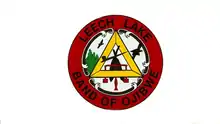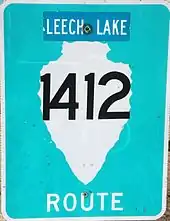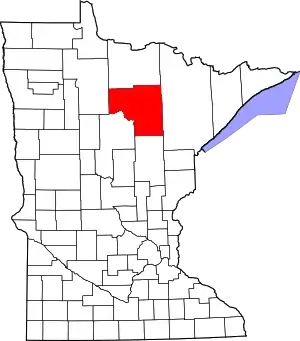Leech Lake Indian Reservation
The Leech Lake Indian Reservation (Gaa-zagaskwaajimekaag in the Ojibwe language) is an Indian reservation located in the north-central Minnesota counties of Cass, Itasca, Beltrami, and Hubbard. The reservation forms the land base for the federally recognized Leech Lake Band of Ojibwe, one of six bands comprising the Minnesota Chippewa Tribe, organized in 1934. The Leech Lake Reservation has the highest population of any reservation in Minnesota, with a resident population of 10,660 indicated by the 2010 United States census.

Geography and demographics

As of the 2010 census, the reservation had a population of 10,660,[1] making it the largest in the state by number of residents. As the reservation covers 972.517 sq mi (2,518.806 km²) of land and 337.392 sq mi (873.841 km²) of water, about one-fourth of its territory is covered by lakes. The largest lakes on the reservation are Leech Lake, Lake Winnibigoshish, and Cass Lake. The band uses 40 lakes for the production of wild rice, and the community produces more rice than any other reservation in the state. The reservation is the second-largest in Minnesota (after the White Earth Indian Reservation) in terms of land area, and the largest in terms of total area.
The core areas of the reservation were established by the 1855 treaty of Washington, which formed three smaller reservations for the Pillager Band of Chippewa Indians, and modified several times thereafter. Under the Indian Reorganization Act of 1934, the present "Greater" Leech Lake Indian Reservation was formed from the merger of the Leech Lake, Cass Lake, and Lake Winnibigoshish reservations of the Pillager Band, the Chippewa Indian Reservation of the Lake Superior Band, and the White Oak Point reservation of the Mississippi Band. A minimal percentage of reservation land is owned by citizens of the Band; additionally, most of the reservation land is now within the Chippewa National Forest, making settlement expansion extremely difficult.
The reservation consists of eleven villages; two additional communities have a substantial number of Leech Lake Band members. Nearly all Leech Lake communities are located in or near the woods of the Chippewa National Forest. The largest community is Cass Lake, situated on the southwestern shores of the eponymous lake. The next largest settlements are Ball Club, Onigum, Inger, and Bena. In some communities, housing is located along only one road, with each side lined with homes.
- Ball Club
- Bena
- Cass Lake
- Deer River (part)
- Inger
- Longville (part)
- Mission
- Oak Point
- Onigum
- Pennington
- Smokey Point
- Squaw Lake
- Sugar Point
- Whipholt
See also

References
- "Profile of General Population and Housing Characteristics: Leech Lake Reservation and Off-Reservation Trust Land, MN" (PDF). United States Census Bureau. 2010. Retrieved 27 April 2012.
External links
Further reading
- Ekidong, Aaniin (2009). Ojibwe Vocabulary Project. St. Paul, Minnesota: Minnesota Humanities Center. ISBN 9780578034645.
- Treuer, Anton (2001). Living Our Language: Ojibwe Tales & Oral Histories. Minnesota Historical Society Press. ISBN 9780873514040.
- Treuer, Anton (2010). Ojibwe in Minnesota. Minnesota Historical Society Press. ISBN 9780873517683.



